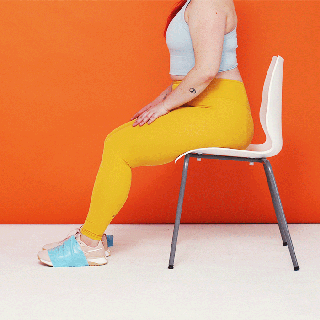If you’re a runner, shin splints have probably ruined your day—or thwarted a workout—at one point or another. While not a magical cure-all, stretches for shin splints can play a big role in warding off the problem (and may help you ease the pain, too).
Shin splints are generally considered an overuse injury, and are often triggered by high-impact activities like running or HIIT training, Kat Torre, DPT, CSCS, an RRCA-certified run coach and co-owner of Pure Sports Physical Therapy in Washington, DC, tells SELF. The repeated force with these kinds of activities causes stress on the bone and attached muscles, which can lead to irritation and pain—often of the “nagging, sometimes sharp and stabby” variety, Torre says.
You can get them in two different spots: Medial shin splints occur on the inner front part of your tibia or shin, while anterior shin splints develop on the outside front of it. Both types are usually linked to a quick increase in activity or drastic change in it. For instance, if you haven’t been running regularly then suddenly start logging 20 miles a week, or you’re hitting hill work hard when you’ve really never done it before, that can put a lot of strain on the shin bone and connected muscles, Torre says. (Unsupportive or worn out footwear can play a role too.)
Muscle imbalances (and in particular, calf tightness) in your lower legs and ankles can also contribute. “The seesaw isn’t even between the front and back, and when you pull too much in one direction, the other can get irritated,” Torre explains. Basically, if you’re running with tight calves, the opposing muscles in the front of your legs can become overworked and end up strained.
In lots of cases, the discomfort with shin splints isn’t severe enough to push you to get immediate medical attention—say, like with a stress fracture, when pain tends to be more significant and usually persists even when you’re not running. Rather, it’s more uncomfortable (which can lead you to shorten your runs or cancel them altogether), and it can feel like it just lingers and lingers.
That’s why having a plan ready can be key to stopping shin splints in their tracks. And the most effective one is multi-pronged: The first part includes a solid dose of regular strength training. The overall goal of this is to keep your glutes, hamstrings, and quads strong enough so they can take the strain off your shins and the surrounding tendons. You’ll also want to specifically strengthen the muscles in the front of your shin, which takes some of the pressure off your tibial bone and reduces pain, Torre adds. Try to fit strengthening into your workout program at least twice a week.
Then there’s the second piece of the puzzle—stretching—which plays an even bigger role if you’re already dealing with shin splint pain. Stretching regularly keeps your lower half balanced and takes the extra pressure off the front of your legs. “As far as maintenance and making sure shin splints don’t come back,” Torre says, “I can’t emphasize enough how important stretching is.” In particular, moves that target your shins and calves can play a big role in easing discomfort.
Torre recommends incorporating dynamic ankle and lower-body stretches into your running warm-ups and more static stretches into your cool-downs. Then, two to three times a week, make it a point to briefly stretch your lower legs (emphasizing your shins and calves) as a standalone routine, even if you just spend two minutes doing it—think of it as maintenance work.
Not sure which stretches for shin splints are the best for keeping the annoying condition at bay? Read on for some great ones to try—along with some tips on how to slot them into your routine.
 Katie Thompson1Seated Toe Drag
Katie Thompson1Seated Toe Drag- Sit up tall in a chair with both feet flat on the floor.
- Drop one of your knees toward the ground and flip your foot so that the tops of your toes are on the floor. This foot will now be underneath the chair.
- Gently pull forward, like you’re trying to “drag” your toes, while keeping your foot on the floor.
- Hold for 15 to 30 seconds. Do 3 sets.
This move stretches the top of your foot into your shin, and really targets your anterior tibialis muscle. “It reduces pressure along your tibia, elongating the anterior tibialis muscle, and increasing your ankle mobility,” Torre explains. Bonus: You can easily sneak this one in while you are sitting at a desk. Katie Thompson2Kneeling Shin Stretch
Katie Thompson2Kneeling Shin Stretch- Kneel on the floor. Slowly sit back into your hips so that your knees are bent, shins are on the floor, and your butt is sitting on top of your feet.
- Place your hands behind you on the floor if you can, or use yoga blocks (as pictured) or a similar prop to make it easier.
- Hold for 15 to 30 seconds. Do 3 sets.
Here’s another stretch that targets your anterior tibialis muscle, but this one allows you to put additional weight into it to increase the intensity, Torre explains. “Really focus on keeping your feet straight while performing this instead of turning your ankles in or out.”
WATCH20-Minute Total Arms Workout
ADVERTISEMENT
 Katie Thompson3Heel Walking
Katie Thompson3Heel Walking- Stand tall with both feet flat on the floor.
- Lift your toes up so that you are putting all of your weight on your heels, and walk across the floor.
- Aim to walk about 20 feet, back and forth. Do 3 sets.
“This helps to activate the anterior tibialis muscle and others to increase blood flow prior to working out,” Torre says. “You can also use this as a regular maintenance exercise to help strengthen the muscles on the front of your shin and help reduce symptoms or prevent shin splints from recurring.” Katie Thompson4Toe Walking
Katie Thompson4Toe Walking- Stand tall with both feet flat on the floor.
- Lift your heels up so that you are putting all of your weight on your toes, and walk across the floor.
- Aim to walk about 20 feet, back and forth. Do 3 sets.
As part of your warm-up, this dynamic stretch and strengthening exercise helps activate your calf muscles and arches of your feet, says Torre. “This exercise can also be used as a regular maintenance exercise as it helps to strengthen your calf muscles—the gastrocnemius, soleus, and posterior tibialis.”
Most Popular
- This Low-Impact Cardio Workout Will Actually Get Your Heart Rate UpBy Amy Marturana Winderl, C.P.T.
- This Chia Pudding Hack Gets You a Fiber-Rich Breakfast in 5 MinutesBy Caroline Tien
- 17 Hot Ways to Stimulate Your Clit for an Amazing OrgasmBy Erica Sloan
ADVERTISEMENT
 Katie Thompson5Toes on Wall Stretch
Katie Thompson5Toes on Wall Stretch- Stand with a wall in front of you in a staggered stance—one foot close to the wall and one about a foot back. Place your palms on the wall for support.
- Bring your front foot close to the wall, putting your hell on the floor and toes up against the wall. Put your weight into your front foot so you can feel the stretch along the lower part of your front leg. (To intensify the stretch, you can rise up on the toes of your back foot and bring your chest closer to the wall.)
- Hold for 15 to 30 seconds, then switch sides and repeat. Do 3 sets.
This exercise targets the muscles on the front of your shins and helps strengthen them so they can withstand heavy repetitive movements, says Torre. “To make this exercise harder, you can bring your feet farther away from the wall and also hinge your upper body forward off the wall.” 6Down Dog Single-Leg Calf Stretch
6Down Dog Single-Leg Calf Stretch- Start in a high plank with your hands directly under your shoulders.
- Pressing through your fingers and palms, shift your weight back to bring your butt to the ceiling, so your body is in an inverted V shape.
- Rise up on the toes of one foot while you press the heel of the opposite foot into the floor.
- For a dynamic stretch, pedal your legs (as pictured), straightening one heel to the floor, holding it for a second or so, and then the other. This is 1 rep. Do 20 reps per leg.
- For a static stretch, hold for 15 to 30 seconds and focus on pushing your heel down into the ground. Do 3 sets, then repeat on the other side.
A variation of downward-facing dog, this move increases ankle mobility and stretches not only your calf muscles, but also your hamstrings and other muscles along the back of your legs, Torre explains. “When using this as part of your dynamic warm up, work on performing single-leg heel raises with a slight hold at the bottom. When using it as a static stretch, you’ll hold it for longer and will really focus on pushing your heel down into the ground,” she says.
Most Popular
- This Low-Impact Cardio Workout Will Actually Get Your Heart Rate UpBy Amy Marturana Winderl, C.P.T.
- This Chia Pudding Hack Gets You a Fiber-Rich Breakfast in 5 MinutesBy Caroline Tien
- 17 Hot Ways to Stimulate Your Clit for an Amazing OrgasmBy Erica Sloan
ADVERTISEMENT
 Katie Thompson7Banded Ankle Dorsiflexion
Katie Thompson7Banded Ankle Dorsiflexion- Sit tall in a chair with your feet flat on the floor in front of you. Loop a resistance band around the center of both feet.
- While keeping one foot planted on the floor, bend the other ankle to bring your toes towards your shin. Your heel should stay on the floor the entire time.
- Slowly bring your toes back to the floor. This is 1 rep.
- Continue for 10 reps. Do 3 sets.
This helps mobilize and strengthen the muscles on the front of your shin using a resistance band instead of your body weight. Try to keep tension in the band the entire time so that you’re working the muscles throughout the ankle’s entire range of motion.Demoing the moves above are Paris Alexandra (GIFs 1-4), founder of the Brooklyn Wellness Club, writer, and yoga and mindfulness facilitator; Nikki Pebbles (GIFs 5 and 7), a special populations personal trainer in New York City; and Jo Murdock (GIF 6), a registered yoga instructor, dancer, and fitness instructor.Related:

